 Unit 03-A: Regional Revitalization and Policies Addressing Japan’s Low Fertility
Unit 03-A: Regional Revitalization and Policies Addressing Japan’s Low Fertility
Makoto Atoh
Honorary Director-General
the National Institute of Population and Social Security Research
1. Introduction
More than 40 years have passed since Japan’s birth rate began to decline. After reaching its peak in 2010, the nation’s total population also began to decline, while population aging accelerated and the percentage of the population aged 65 and above exceeded 25% in 2013. Recognizing the declining population as one of the greatest challenges facing Japan, the Abe Cabinet formulated the Act for Overcoming the Population Decline and Vitalizing Local Economy in Japan (abbreviated as the “Regional Revitalization Law” below) in September 2014. Based on this law, in December of the same year the Cabinet approved the “Long-term Vision for Overcoming the Population Decline and Vitalizing Local Economy in Japan” and the “Comprehensive Strategy” for Regional Revitalization, which set twin policy targets: 1) To realize the total fertility rate of 1.8 which would be achieved if the desire for marriage and births among Japanese young people would have been satisfied, and 2) To halt the nation’s population decline. Historically speaking, this is the first time that the Japanese government has adopted a fully-fledged population policy since the pre-war government approved Guidelines for Population Policy in 1941. In this paper, I wish to consider the background to and the meaning of the government’s new population policy.
2.Japan’s Low Fertility: Trends and Background Factors
In the mid-1970s, when the period of high economic growth was over and Japan had become an affluent nation, the nation’s total fertility rate (“TFR” below) dropped below replacement level and began to decline. After a period of rapid decline during the bubble era, Japan’s TFR fell below 1.5 in 1995. During the Heisei recession, the TFR continued a basically consistent decline. Reaching its lowest point at 1.26 in 2005, the figure began to gradually recover, reaching 1.42 in 2014 (Figure 1).
Japan shares the phenomenon of a below-replacement fertility with other advanced nations. The TFR of European nations, the US and others (limited in this consideration to advanced nations of the former Western Bloc) suddenly began to decline following the postwar baby boom which had continued for around 20 years, and by the 1970s the TFR in these nations had become largely below replacement level. Since then, almost none of these countries has increased its TFR to replacement level and maintained this level (Figure 1).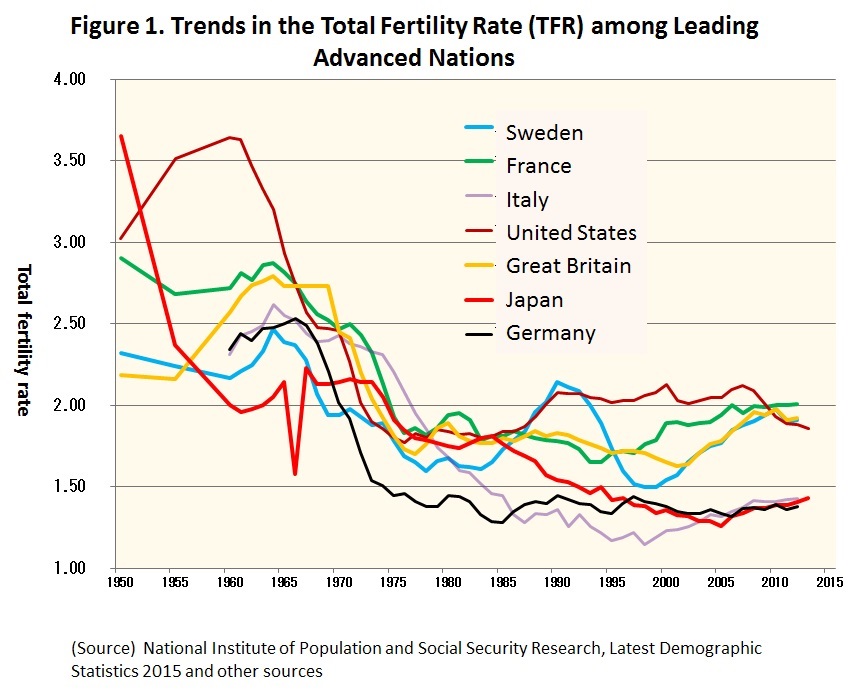
However, there is a clear polarization in terms of the status of low birth rates in the advanced nations of Europe, the US and others. The TFR of the Nordic nations, the English-speaking nations, and the French-speaking nations largely did not decline below 1.5, and displayed rapid increases from 1990s to 2000s to reach present levels generally in excess of 1.7. By contrast, the TFR of the southern European and the German-speaking nations declined below 1.5, and has since not exceeded this figure.
The TFR of the four nations and regions comprising the Asian NIEs declined below 1.5 in the 1990s and also the TFR of the eastern European nations did it after the collapse of the Eastern Bloc, and both remain far below 1.5 today. With a TFR of 1.5 as the baseline, nations with TFR above this figure can be termed “moderately low-fertility countries,” and nations with TFR below this figure can be termed “very low-fertility countries.”
It is normal to consider the causes of low fertility in advanced nations in two steps, looking at demographic factors first and socio-economic and cultural factors secondly. The demographic factor here is the postponement of childbirth until later in life. In the periods during which birth rates were declining, without exception the fertility rate among women in their 20s declined in the advanced nations, and this resulted in a decline in TFR. However, two differences can be observed in this process between moderately low-fertility countries and very low-fertility countries. One of these is that cohabitation by couples and its resultant extra-marital births were more widespread as alternatives to marriage and marital births in moderately low-fertility countries than very low-fertility countries, and as a result fertility has not declined as greatly among the 20-30 age group. Another is that following the postponement of childbirth among the 20-30 age group, there is a significant recuperation among the 30-40 age group in moderately low-fertility countries (Figure 2a). As a result, the completed cohort fertility rate in countries with moderately low fertility rates has remained close to 2 up to the present.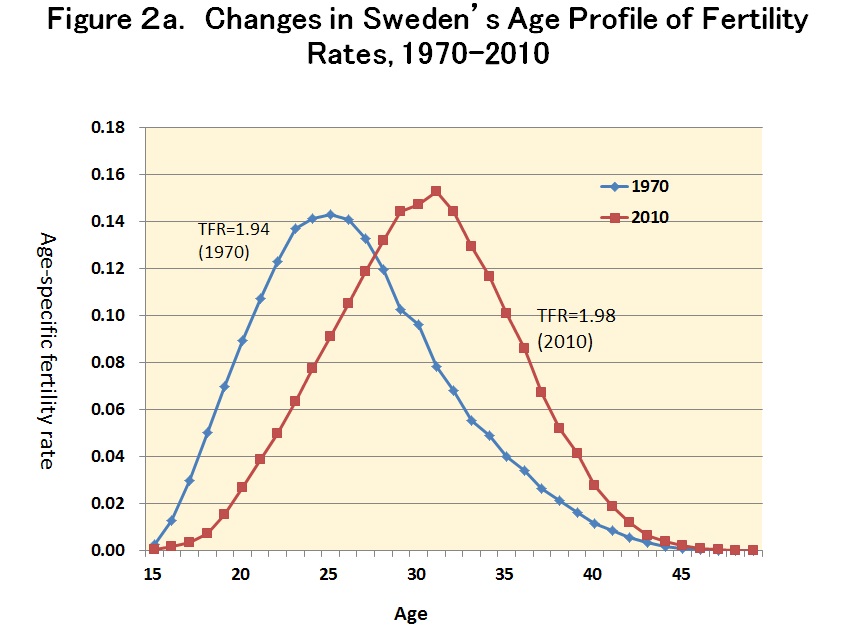
(Source) Eurostat database (https://ec.europa.eu/eurostat/data/database#)
Data Navigation Tree / Database by Themes / Population and social conditions / Demography and migration (pop) /
Fertility (demo_fer) / Fertility rates by age
In Japan, a very low-fertility country, there has been only modest increase in the incidence of cohabitation and the birth of children outside marriage; the postponement of marriage leads directly to the postponement of childbirth, and is also linked to lifetime celibacy and lifetime childlessness. Consequently, the decline in the fertility rate among the 20-30 age group is significant and there is little recovery in the 30-40 age group (Figure 2b), and the completed cohort fertility rate has already fallen below 1.5. It is estimated that about 90% of the decline in Japan’s TFR is due to the postponement of marriage (late marriages or increasing lifetime celibacy).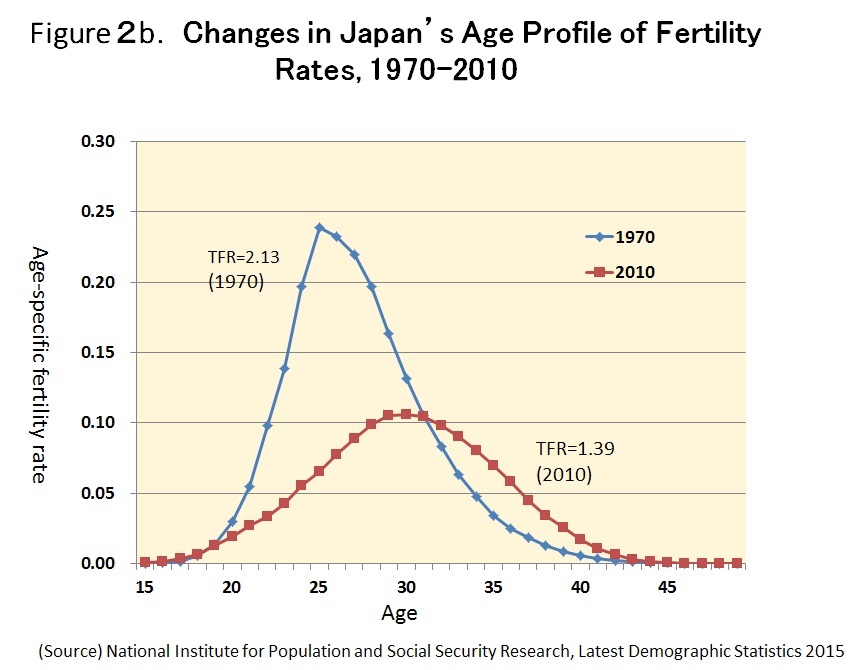
The socioeconomic and cultural factors in low fertility are not as clear as this demographic factor. According to Becker’s economic framework, fertility is determined by household income and the direct and indirect costs of raising children. If we apply this framework to the case of Japan, we can point to the sluggish growth of wages and the increase in the number of young people in irregular employment since the collapse of the bubble economy as household income-related factors. With regard to the direct cost of raising children, we see an increased burden of childcare prior to schooling and educational expenses resulting from the trend towards higher educational levels. In the area of indirect expenses, we can indicate increased opportunity costs of child-raising with the advance of women into the employment/labor market (the difficulty of balancing work and child-raising). The opportunity cost of raising children is the focus of discussion in other advanced countries (in connection with the issue of gender equality).
The issue of value systems cannot be ignored as a factor in promoting low fertility. Value systems which privilege traditional gender roles are strongly rooted in very low-fertility countries including Japan, while in moderately low-fertility countries, value systems promoting gender equality are strong (Figure 3). This is reflected in differences between very and moderately low-fertility countries in the treatment of men and women in the labour market and company hierarchies and in the division of housework in the home. It also affects the formation of partnerships, and in countries such as Japan, which have very traditional views of the family, inhibits cohabitation by couples and the birth of children outside marriage.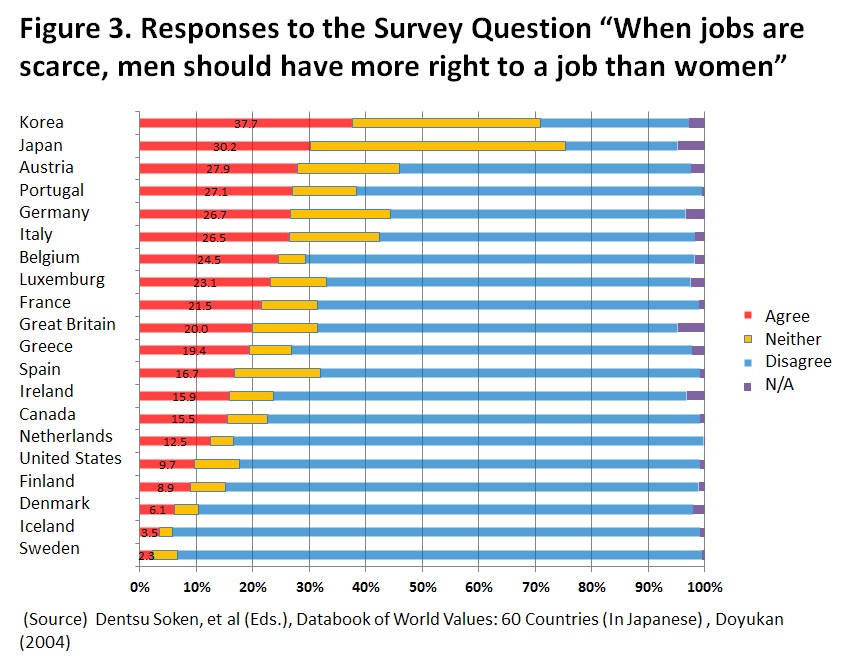
3.Policy Responses to Japan’s Low Fertility and Their Effectiveness
Policy responses to the fertility rate always invite controversy. The “1.57 shock” in 1990, the year when the government announced that TFR in the previous year hit the lowest, 1.57, ever-recorded in the vital statistics, prompted the Japanese government to commence a policy of enhancing its support for child-raising. In doing so, it was immediately criticized, among other things, for reviving the pre-war “increase and multiply” policy. The Basic Act for Measures to Cope with Society with Declining Birthrate, established in 2000, set its policy goal as halting the decline in Japan’s fertility, and was the target of the same criticism from women’s groups and other sources. However, the core of the measures which successive governments have continued up to the present has been welfare and labor policies seeking to reduce the burden of child-raising (direct expenses for children and the burden of balancing work and child-raising) on younger generations. In this respect, the measures have not been significantly out of step with reproductive rights, indicating women’s self-determination of their own pregnancies and childbearing, agreed on at the International Conference on Population and Development held in Cairo in 1994.
If we focus on trends in the fertility rate, the policy effects of the government’s measures to address Japan’s low fertility, which have been in effect for a quarter of a century, have been limited. However, the policy value of these measures should be judged on the basis of the actual level of policy effort successive governments have focused on the provision of support for child-raising. If we consider data for the total value of family-related social expenditure (including both economic support for child-raising and support for balancing work and family) and education-related public expenditure (as a ratio of GDP for 2011), we see that Japan is in the lowest position for 21 advanced nations, and its expenditure is only 44% that of Denmark, the nation in the top position (Figure 4). Given that Japanese governments have failed to make adequate efforts to reduce the burden of child-raising despite their avowed intention to strengthen support measures, it can perhaps be seen as only natural that no visible effect in promoting increased fertility has ensued from these efforts.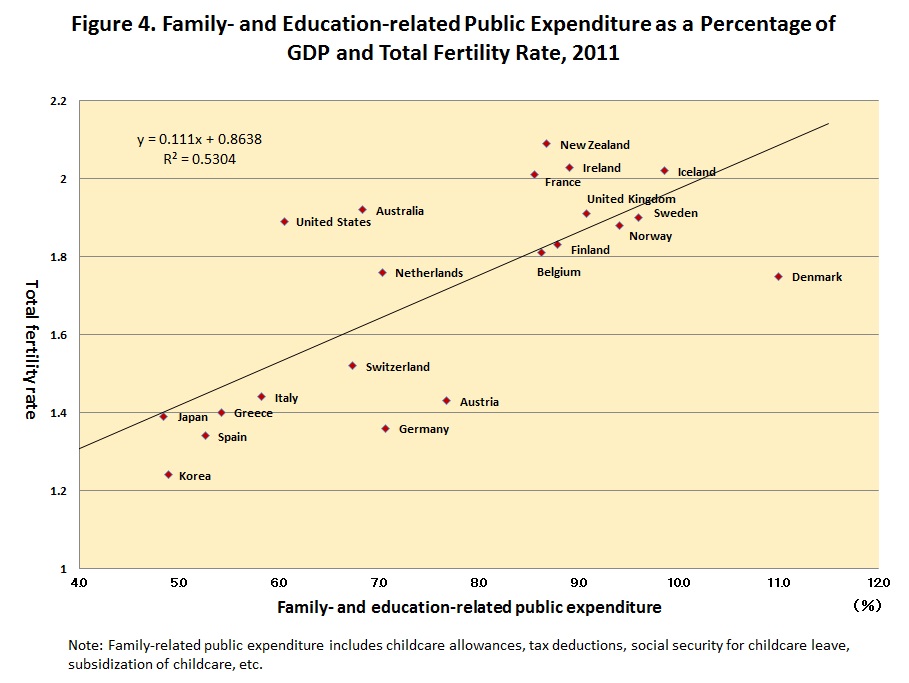
(Source) OECD Family Database 2014 (http://www.oecd.org/els/family/database.htm)
4.Regional Revitalization Policies and the Target TFR
As indicated at the beginning of this paper, in its Long-term Vision for Regional Revitalization, the Abe administration has set the target of realizing the desire for marriage and procreation among the younger generation, seeking to increase the nation’s TFR to around 1.8 by this means. If this scheme is successful and the TFR increases to around 1.8 by 2030 and returns to replacement level by 2040, the government estimates that Japan’s total population, 127 million today, will be 100 million in 2060, stabilizing at 90 million over the long term.
The provision of assistance by the government in order for the younger people to realize their desired number of children accords with the principles of human rights, and thus does not raise any question. Nevertheless, if the realization of the target fertility rate of 1.8 is raised as a policy goal, then the viability and morality of this target must be questioned.
The method by which this figure was obtained is unclear, but according to materials published by the Nihon Sosei Kaigi, a private organization influencing strongly Abe administration’s Regional Revitalization policies, estimates of 1.8 as the desired number of children per woman aged 30-34 were based on the following formula:
{(Percentage of married women x Mean number of children intended by married couples) + (Percentage of never-married women x Percentage of never-married women desiring to marry x Mean desired number of children for never-married women)} x the effect of separation or bereavement
{( 34% × 2.07 persons )+( 66% × 89% × 2.12 persons )}× 0.938
The figures for intended number of children, desired number of children, and the effect of separation or bereavement (in reducing the mean number of children ever-born) here do not deviate significantly from the actual status. The problem is the possibility of realizing the percentage of never-married women who desire to marry. If the desire for marriage of all the never-married women was satisfied, 93% of women would be married (the percentage of married women (34%) + the percentage of never-married women desiring marriage (59%) = 93%). However, the percentage of women aged 30-34 who had been ever married declined from 92% in 1975 to 66% in 2010. Taking into consideration the fact that unless the marriage pattern which has taken hold since Japan’s birth rate commenced its decline is reversed in the next 15 years, it will be impossible to realize a TFR of 1.8 by 2030, the feasibility of this policy target must be considered very low. Further, a numerical target for a performance index in relation to the realization of the desire to marry has been set in the government’s Comprehensive Strategy for Regional Revitalization, but the diversification of types of partnership, the vagueness of “desire to marry,” and the complexity of the factors involved in choosing a spouse make it extremely difficult to consider an index of this type as one which should be set as a valid national or regional government target.
It is perfectly acceptable that the government calculates the total fertility rate which would be achieved if the desire for marriage and births among Japanese young people would have been realized and shows it as an indicator. However, if the realization of this fertility rate in 15 years is set as a concrete policy target, then there is every chance that peoples’ lifestyle choices, which must inherently be free, may come under political and social pressure in some areas, and that this will result in violations of reproductive rights. None of the Western nations of the West, which stress the importance of human rights, have set concrete numerical targets for their fertility rates.
5.Conclusion
The completed fertility rate for women born in 1970 has already fallen below 1.5 in Japan. Some scholars believe that Japan has fallen into a “low fertility trap,” a situation in which low fertility leads to further declines in fertility. This situation is not an easy one for a nation to extract itself from.
Japan’s policies of support for child-raising can still not be considered adequate in comparison to those of moderately low-fertility countries. If the government’s regional revitalization policies were able, in accord with the specific circumstances of individual regions, to stabilize employment and income among young people and significantly reduce the cost of raising children, the effect would be to make it easy for young people to get married, and to contribute to the realization of the number of children married couples desire to have. The list of policy issues which need to be addressed is well known, and includes bringing young people from irregular to regular employment, increasing public expenditure to offset the expense of education, expanding childcare services and reducing excessive working hours. The realization of these goals is an urgent issue. The advantages of establishing an unfeasible fertility rate as a policy target are minimal, but the disadvantages are great.
In addition, the common point shared by very low-fertility countries including Japan is a deeply-rooted view of the family and gender that emphasizes the division of gender roles. Remembering that today’s low fertility in advanced nations commenced contemporaneously with the higher education and advancement of women into the workforce, we must be aware that there will be no solution to the issue of low fertility without the creation of a society that makes equality between men and women fundamental (a gender-equal society), as is the case in moderately low-fertility countries.
<Reference>
- Atoh, Makoto (2005) ’Shoushika to Kazokuseisaku (Low Fertility and Family Policy),’ in Ohbuchi et al. (eds.) “Shoushika no Seisakugaku (Policy Studies of Low Fertility),” Hara Shobo, pp.33-58.
- Atoh, Makoto (2014) ’Nihon no Shusshouritsu wa Dokomade Kaihuku Shiuruka? (To what extent can the birth rate in Japan be recovered?),’ in “Tohkei (Statistics)” Vol.65, No.1, January 2014, pp.60-64.
- Ohbuchi, Hiroshi et al. (eds.) (2004) “Shoushika no Jinkougaku (Demography of Low Fertility),” Hara Shobo.
- Takahashi, Shigesato et al. (eds.) (2015) “Jinkougenshou to Shousika Taisaku (Declining Population and Measures Addressing Low Fertility),” Hara Shobo.
- Dalla Zuanna, Gianpiero et al. (eds.)(2004)“Strong Family and Low Fertility: A Paradox?,” Kluwer.
- Ogawa, Naohiro et al.(eds.)(2014)“Low Fertility and Reproductive Health in East Asia,” Springer.